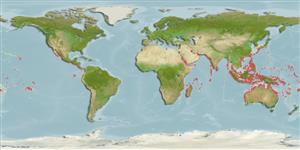Common names from other countries
Environment: milieu / climate zone / depth range / distribution range
экология
; солоноватоводный; пределы глубины 0 - 10 m (Ref. 96667). Tropical
Indo-Pacific.
Length at first maturity / Size / Вес / Возраст
Maturity: Lm ? range ? - ? cm Max length : 8.0 cm CW самец/пол неопределен; (Ref. )
Surface of carapace smooth, ridges low but distinct; front with 6 equal-sized, rounded lobes. Color: dark to olive green overall.
Also caught by nets (Ref. 343). This species possess toxins but in low toxicities, and are therefore considered as a toxin-free crab (Ref. 130560). Found along the neritic zone (Ref. 97241). Inhabits shallow non-reef habitat with soft substrates (Ref. 106854), and intertidal mudflats (Ref. 128960). Estuarine (Ref. 106854). Prefers areas near mangroves, on mangrove swamps per se (Ref. 8752) or with muddy-rocky substrates (Ref. 343) in intertidal platforms (Ref. 8752). Also found in reef areas. A free-living predatory carnivore (Refs. 97241, 128960). Feeds mainly on slow-moving invertebrates colonizing mangrove swamps; also a scavenger (Ref. 8752).
Life cycle and mating behavior
половая зрелость | размножение | нерест | икра | Fecundity | личинки
Members of the order Decapoda are mostly gonochoric. Mating behavior: Precopulatory courtship ritual is common (through olfactory and tactile cues); usually indirect sperm transfer.
Основная ссылка
ссылки | координатор | соавторы
Ng, P.K.L. 1998. (Ref. 343)
Статус Красного Списка МСОП (Ref. 130435)
Статус СИТЕС (Ref. 108899)
Not Evaluated
Not Evaluated
Угроза для людей
Использование человеком
рыболовство: коммерческий
| FishSource | Sea Around Us
инструменты
дополнительная информация
ресурсы в Интернет
Estimates based on models
Preferred temperature
(Ref.
115969): 24.3 - 29.3, mean 28.3 (based on 3830 cells).
устойчивость к внешним воздействиям
высокий, минимальное время удвоения популяции до 15 месяцев (K=1.7).
Уязвимость
Low vulnerability (10 of 100).
Категория цены
Unknown.
